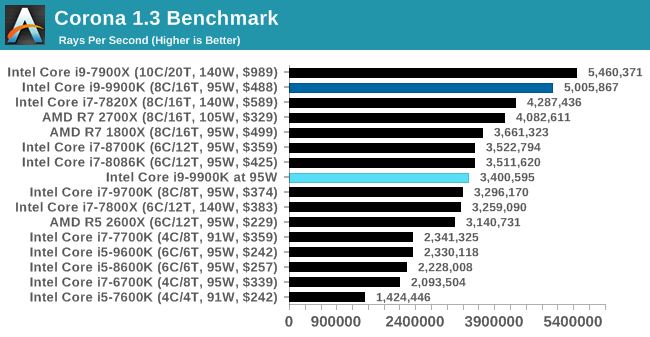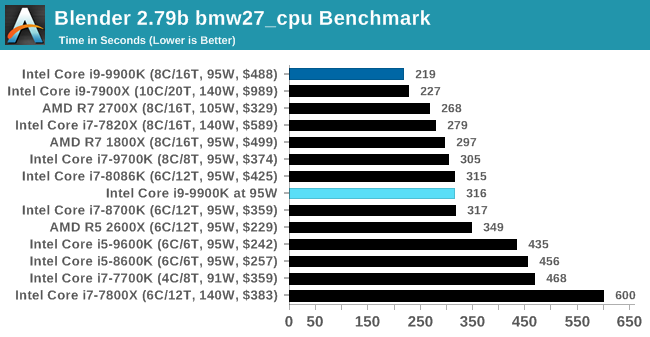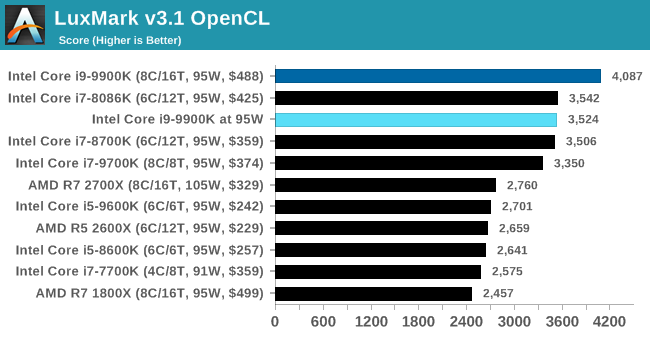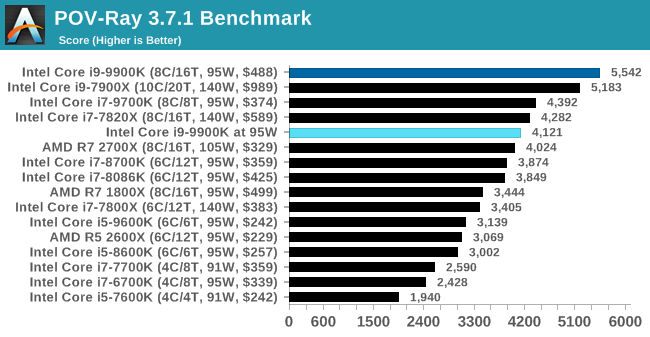The Intel Core i9-9900K at 95W: Fixing The Power for SFF
by Ian Cutress on November 29, 2018 8:00 AM ESTCPU Performance: Rendering Tests
Rendering is often a key target for processor workloads, lending itself to a professional environment. It comes in different formats as well, from 3D rendering through rasterization, such as games, or by ray tracing, and invokes the ability of the software to manage meshes, textures, collisions, aliasing, physics (in animations), and discarding unnecessary work. Most renderers offer CPU code paths, while a few use GPUs and select environments use FPGAs or dedicated ASICs. For big studios however, CPUs are still the hardware of choice.
All of our benchmark results can also be found in our benchmark engine, Bench.
Corona 1.3: Performance Render
An advanced performance based renderer for software such as 3ds Max and Cinema 4D, the Corona benchmark renders a generated scene as a standard under its 1.3 software version. Normally the GUI implementation of the benchmark shows the scene being built, and allows the user to upload the result as a ‘time to complete’.
We got in contact with the developer who gave us a command line version of the benchmark that does a direct output of results. Rather than reporting time, we report the average number of rays per second across six runs, as the performance scaling of a result per unit time is typically visually easier to understand.
The Corona benchmark website can be found at https://corona-renderer.com/benchmark

When we apply a full-fat rendering test, the 9900K at 95W scores around the i7-9700K which is a similar CPU with no hyperthreading.
Blender 2.79b: 3D Creation Suite
A high profile rendering tool, Blender is open-source allowing for massive amounts of configurability, and is used by a number of high-profile animation studios worldwide. The organization recently released a Blender benchmark package, a couple of weeks after we had narrowed our Blender test for our new suite, however their test can take over an hour. For our results, we run one of the sub-tests in that suite through the command line - a standard ‘bmw27’ scene in CPU only mode, and measure the time to complete the render.
Blender can be downloaded at https://www.blender.org/download/

Similar scenes with Blender, where the 9900K at 95W is actually 50% slower, and performs around the mark of the 9700K.
LuxMark v3.1: LuxRender via Different Code Paths
As stated at the top, there are many different ways to process rendering data: CPU, GPU, Accelerator, and others. On top of that, there are many frameworks and APIs in which to program, depending on how the software will be used. LuxMark, a benchmark developed using the LuxRender engine, offers several different scenes and APIs.
In our test, we run the simple ‘Ball’ scene on both the C++ and OpenCL code paths, but in CPU mode. This scene starts with a rough render and slowly improves the quality over two minutes, giving a final result in what is essentially an average ‘kilorays per second’.


The drop in our Luxmark test isn't as severe as what we see in blender, but the 95W mode causes the 9900K to be again around the level of a 9700K.
POV-Ray 3.7.1: Ray Tracing
The Persistence of Vision ray tracing engine is another well-known benchmarking tool, which was in a state of relative hibernation until AMD released its Zen processors, to which suddenly both Intel and AMD were submitting code to the main branch of the open source project. For our test, we use the built-in benchmark for all-cores, called from the command line.
POV-Ray can be downloaded from http://www.povray.org/













101 Comments
View All Comments
Hul8 - Friday, November 30, 2018 - link
The fact that all motherboard vendors do the exact same thing could lead one to draw the conclusion that the practice is actually mandated and suggested by Intel - unofficially of course.Higher benchmark results will look good especially for casual readers (who only look at certain performance graphs and skip the power consumption numbers), all the while allowing Intel to market them as "95 W" parts.
Alexvrb - Friday, November 30, 2018 - link
If Intel didn't like this practice they could hardcode behavior in the CPU itself. Oh wait, they DO... and they allow this because it makes them bench better. Meanwhile look at their cheaper locked "95W" models, I bet you won't see them auto-overclocking to 150W+ even with the board defaulting to "unlimited" TDP.Gastec - Wednesday, June 19, 2019 - link
It should be ILLEGAL for motherboard makers to go out of Intel's specifications by default. All overclocking should be entirely the responsibility of the user.rsandru - Thursday, November 29, 2018 - link
It's not capping, it's running the CPU according to the Intel datasheet specification.Operating the component beyond specification is usually called overclocking which is nice and all but doesn't allow an unbiased comparison of the different products.
LTC8K6 - Thursday, November 29, 2018 - link
Why not clamp it to the Intel spec?TheinsanegamerN - Thursday, November 29, 2018 - link
Because motherboards dont do that, they are letting the 9900k run wild.Alexvrb - Friday, November 30, 2018 - link
With Intel's blessing. If Intel wasn't onboard, they'd clamp the behavior on-chip, and you'd have to manually overclock to override TDP for any length of time (for unlocked chips, anyway).Anyway my prediction is that if Intel continues this practice, AMD just starts following suit more and more as time goes on. We'll see.
djayjp - Thursday, November 29, 2018 - link
So many of these tests would run better (faster and with much greater efficiency) on a highly parallel GPU instead.PeachNCream - Thursday, November 29, 2018 - link
You may have missed the point of the article.melgross - Thursday, November 29, 2018 - link
What I find interesting about all of this is that with mobile ARM chips the exact same characteristics are called throttling instead. Possibly we should get these naming conventions together? Either x86 chips throttle, as mobile ARM chips do, or mobile ARM chips have turbo mode too.